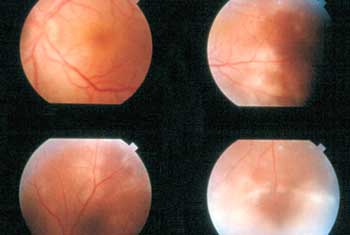Be on the lookout for ‘the great masquerader’
It has been said that “if you know syphilis, you know medicine” because of the wide reach the Treponema pallidum bacterium can have on the body’s entire system.
“It affects just about every part of the body and it can present in so many different ways and has so many different stages,” Leonid Skorin Jr., OD, DO, FAAO, FAOCO, of Albert Lea, Minn., told Primary Care Optometry News.
According to a report by the Centers for Disease Control and Prevention and the U.S. Department of Health and Human Services, the rate of primary and secondary syphilis has increased each year since 2001. In 2005, syphilis cases reported to the CDC rose from 7,890 in 2004 to 8,724 in 2005, an increase of 10.6%.
‘The great masquerader’
In its ocular manifestations, the sexually transmitted disease known as “the great masquerader” presents itself much like any other inflammatory condition, often perplexing practitioners who are not trained to look for it.
According to the American Academy of Optometry’s Web site (www.aaopt.org), syphilis is associated with these ocular diseases: interstitial keratitis, episcleritis, scleritis, iritis, iris papules, chorioretinitis, papillitis, retinal vasculitis and exudative retinal detachment.
If the disease is active, patients may complain of a change in vision, headaches and sometimes an altered mental state if the STD has started to affect parts of the central nervous system. If the congenital form is inactive, an OD will be able to spot a “salt-and-pepper” fundus. Uveitis can be seen after the secondary phase of acquired syphilis (see sidebar on syphilis phases).
“The bottom line is that you should always keep it in mind as a diagnosis, especially if you have run all the tests and don’t know where else to go,” Dr. Skorin said, adding that doctors should also be on the lookout for madarosis, or loss of hair on the eyebrows and eyelashes.
Ocular syphilis often presents itself in the retina, Leo P. Semes, OD, a PCON Editorial Board member, explained in an interview.
“Infections and consequent inflammatory processes can occur in the posterior pole of the eye and they can have a number of etiologies,” he said. “One of the ways to categorize them is by infectious agents, so whether it’s fungal like histoplasmosis or bacterial like syphilis, sometimes they can look similar.
“Sort out the risk factors and then try to decide what category it fits in etiologically,” Dr. Semes continued. “It’s more of a diagnosis of exclusion.”

The link to HIV
Dr. Semes urged doctors to be aware of a syphilis diagnosis especially when treating HIV-positive patients who are at higher risk. “That’s not surprising, because even though it’s a bacterial infection, it’s something that can be spread by sexual contact,” Dr. Semes said.
Dr. Skorin added, “They are more at risk because their immune system is poor, so they can’t fight off the virus or, in this case, the syphilis.”
According to the CDC, “Genital sores (chancres) caused by syphilis make it easier to transmit and acquire HIV infection sexually.”
A recent case
Dr. Skorin recently treated a woman in her mid-30s who had unilateral interstitial keratitis. “She originally had inflammation and diffuse corneal edema, which slightly improved with steroid treatment,” he said.
Then deep stromal blood vessels started growing from her peripheral cornea to the center of her eye. “It was evolving into something more sinister, so I knew I needed a more thorough workup,” Dr. Skorin said.
A blood test confirmed syphilis, and Dr. Skorin said a good lesson can be learned from the experience. “Just because someone doesn’t look the part of having an STD, don’t rule it out,” Dr. Skorin said. “Don’t be deceived by appearances.
|
Image: Reprinted with permission from Gómez Leal A, Muñoz Rodriguez P. The Atlas of Ophthalmology. Thorofare, NJ: SLACK Incorporated; 2002. |
Tests and treatment options
Tests to run include the venereal disease research laboratory test (VDRL), a screening tool that does not detect syphilis outright. The fluorescent treponemal antibody absorption (FTA-ABS) test for T. pallidum antibodies confirms a syphilis diagnosis and can be used in all stages of the disease. It does not, however, report if the disease is active.
“If I have a patient with unexplained uveitis or vitritis I order a number of different tests for autoimmune disease,” Dr. Skorin said. “I also order a RPR [rapid plasma reagent] at the same time.” The RPR, he said, is a serologic test like the VDRL that detects syphilis. He uses it as a screening tool to determine if he should conduct more blood tests specifically for the disease.
In its early stages, syphilis is easy to cure with an intramuscular injection of penicillin, which also is useful when treating its related eye diseases, Dr. Skorin said.
For more information:
- Leonid Skorin Jr., OD, DO, FAAO, FAOCO, practices in Albert Lea, Minn., and writes and lectures on ocular disease and neuro-ophthalmic disorders. He may be contacted at the Albert Lea Eye Clinic, Mayo Health System, 1206 W. Front St., Albert Lea, MN 56007; (507) 373-8214; fax: (507) 373-2819; e-mail: skorin.leonid@mayo.edu.
- Leo P. Semes, OD, is an associate professor of optometry, University of Alabama at Birmingham and a member of the Primary Care Optometry News Editorial Board. He may be contacted at 1716 University Blvd., Birmingham, AL 35294-0010; (205) 934-6773; fax: (205) 934-6758; e-mail: lsemes@uab.edu.
References:
- Centers for Disease Control and Prevention. Sexually Transmitted Disease Surveillance, 2005. Atlanta, GA: U.S. Department of Health and Human Services. Available at http://www.cdc.gov/STD/syphilis/default.htm. Accessed July 16, 2007.
- Chao JR, Khurana RN, Fawzi AA, Reddy HS, Rao NA. Syphilis: Reemergence of an old adversary. Ophthalmol. 2006;113:2074-2079.
See Dr. Leo P. Semes present at PCON’s 2-credit course held during SECO 2009! Click here for details

